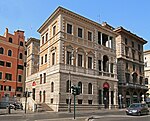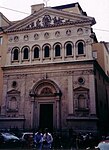Santi Benedetto e Scholastica
17th-century Roman Catholic church buildings in ItalyChurches of Rome (rione Sant'Eustachio)National churches in RomeRoman Catholic churches in Rome

Santi Benedetto e Scolastica is a church in Rome on the Via di Torre Argentina, although its postal address is Vicolo Sinibaldi 1.
Excerpt from the Wikipedia article Santi Benedetto e Scholastica (License: CC BY-SA 3.0, Authors, Images).Santi Benedetto e Scholastica
Vicolo Sinibaldi, Rome Municipio Roma I
Geographical coordinates (GPS) Address External links Nearby Places Show on map
Geographical coordinates (GPS)
| Latitude | Longitude |
|---|---|
| N 41.896833333333 ° | E 12.476305555556 ° |
Address
Santi Benedetto e Scolastica all’Argentina
Vicolo Sinibaldi
00186 Rome, Municipio Roma I
Lazio, Italy
Open on Google Maps









